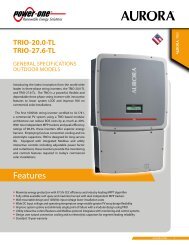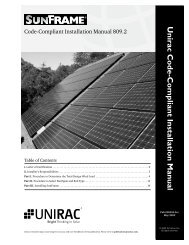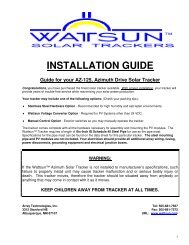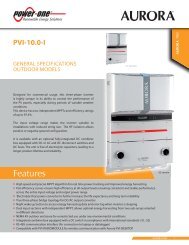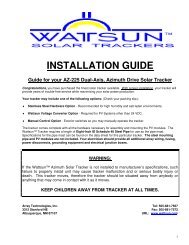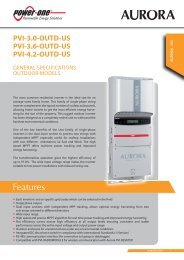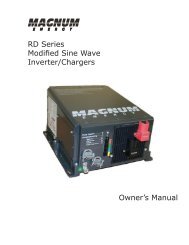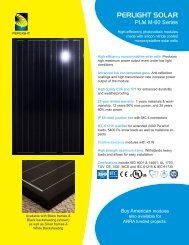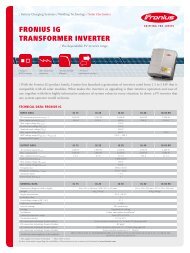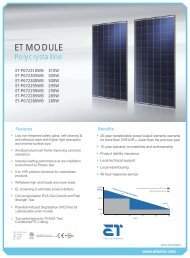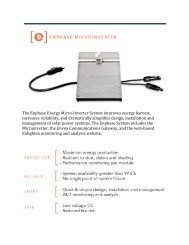MS Series Owner's Manual - Magnum Energy
MS Series Owner's Manual - Magnum Energy
MS Series Owner's Manual - Magnum Energy
You also want an ePaper? Increase the reach of your titles
YUMPU automatically turns print PDFs into web optimized ePapers that Google loves.
Installation<br />
2.4 DC Wiring<br />
This section describes the inverter’s required DC wire sizes and the recommended disconnect/<br />
overcurrent protection and how to make the DC connections to the inverter and the<br />
battery bank.<br />
Refer to figure 2-4 when connecting the DC wires.<br />
WARNING: Even though DC voltage is “low voltage”, significant hazards may be<br />
present, particularly from short circuits of the battery system.<br />
CAUTION: The inverter is NOT reverse polarity protected which means that if the<br />
negative and positive battery voltage is connected backwards to the inverter, the<br />
inverter will likely be damaged. You should verify the correct voltage polarity using a<br />
voltmeter BEFORE connecting the DC wires.<br />
CAUTION: Before wiring the DC cables, review the safety information at the beginning<br />
of this manual and the following to ensure a safe and long-lived system.<br />
Info: DO NOT connect the battery cables to the inverter until all wiring is complete and<br />
the correct DC voltage and polarity has been verified.<br />
• When the inverter is installed in a Photovoltaic System, the NEC requires that the DC circuit<br />
conductors and overcurrent devices to the inverter be sized to carry not less than 125% of<br />
the inverter’s maximum current rating.<br />
• The DC positive and negative cables connected to the inverter from the battery bank should<br />
be tied together with wire ties or electrical tape approximately every 6 inches. This helps<br />
improves the surge capability and reduces the effects of inductance, which improves the<br />
inverter waveform and reduces the wear of the inverter’s filter capacitors.<br />
• Crimped and sealed copper ring terminal lugs with a 5/16” hole should be used to connect the<br />
DC wires to the inverter’s DC terminals.<br />
• The battery bank voltage MUST match the DC voltage required by the inverter (i.e., 24-volt<br />
battery bank for a 24-volt inverter) or the inverter may be damaged.<br />
• To ensure the maximum performance from the inverter, all connections from the battery bank<br />
to the inverter should be minimized, the exception is the DC overcurrent disconnect in the<br />
positive line and a shunt in the negative line. Any other additional connection will contribute<br />
to additional voltage drops and these extra connections points may loosen during use.<br />
• All wiring to the battery terminals should be checked periodically (once a month) for proper<br />
tightness. The torque requirement for the DC terminals is between 10 to 12 ft lbf (13.6<br />
to 16.3 N-m). If you don’t have a torque wrench, ensure all DC terminals are tight and<br />
cannot move.<br />
• Be aware that overtightening or misthreading the nuts on the DC terminals can cause the<br />
bolts to strip and snap/break off.<br />
• Make sure cables have a smooth bend radius and do not become kinked. Place long cable runs<br />
in conduit and follow existing wire runs where possible.<br />
• A brief spark or arc may occur when connecting the battery cables to the inverter DC terminals;<br />
this is normal and due to the inverter’s internal capacitors being charged.<br />
• Color code the DC cables/wires with colored tape or heat shrink tubing: RED for positive (+);<br />
WHITE for negative (-); and GREEN for DC ground to avoid polarity problems.<br />
© 2009 <strong>Magnum</strong> <strong>Energy</strong> Inc.<br />
Page 13




